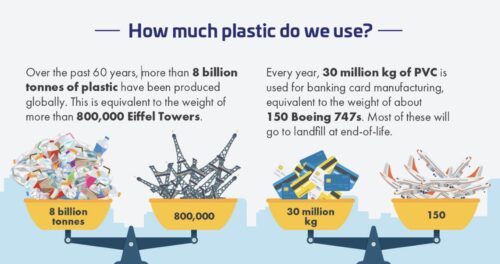17 April 2023

Since 2007 the finance sector has been moving towards complete digitisation. Despite the invisibility of most transactions nowadays, and the disappearing faces of banks from most high streets, the finance sector is still in need of packaging. Although most people are using their phone to complete transactions, having a physical card is still necessary – not only because it’s essential for some transactions and online banks to authenticate with a physical card, but also because not everyone has access to or knows how to use a banking app or smartphone.
Having a physical card is also a great way for banks to connect with their customers – since there is a high chance that the relationship will have been purely digital until the point at which the card is sent. It is now that the bank can put their brand forward, in a way that not only makes the customer feel seen as an individual, but also makes the bank a trustworthy partner for the customer to invest their hard earned money into. Banks more than most service-based B2C companies need to have trust at the forefront of their brand – that’s why there can be a problem with blanding in the finance sector, (for more information on why blanding is such a problem, check out the article on the BPAK blog Simple For Scrolling: Blanding).
So, finance packaging. Unfortunately most bank cards are made of plastic, this is because it is a majorly durable material that is not only going to last the four or so years that the customer has the card but it’s also waterproof, slim enough to fit in a pocket or wallet and can be molded to put the right numbers and information onto not only the front but also the back. Plastic is bad for the environment, yes, but it’s great for bank cards.
However, finance packaging is changing with the implementation of more advanced technology. At the moment more than 8 billion tonnes of plastic have been produced globally over the past 60 years, (the equivalent to the weight of more than 800,000 Eiffel Towers). Every year the banking card industry creates 900 million kg CO2, not just in producing their bank cards but also in mailing them out and then mailing out the PIN for the card in a separate mailer, (a practice which is not unusual to increase security for the customer).

Sustainable banking is a new movement in the finance sector that is moving banks towards a greener future. There are lots of different materials available for making bank cards – not just plastic; but plastic is cheap, easy to produce and because it’s been used for years it’s the norm. It costs businesses more to find a new material than to continue with one which is producing tonnes of carbon and isn’t biodegradable.
One of the material options is corn. Corn is not only natural, it’s also biodegradable, reusable and recyclable. For example the finance sector creates around 600 million bank cards per year, converted into corn this
means 7000 tonnes of corn, (to give some context to that amount, Nebraska alone creates 35 million tonnes of corn per year). The ‘corn card‘ has the potential to transform the finance sector into a more sustainable area; considering how important it is to younger generations to invest in businesses that prioritize sustainability.
Another option is rPVC plastic, for example Starling Bank has created the first bank card made from recycled plastic, (75% of the card is made from recycled plastic, the other 25% is made from virgin materials).
There are so many different options for bank card packaging – not just the physical card but the holder it comes in. Due to the fact that it’s going to be the one chance you have to physically interact with your customers until they potentially come into a branch, you want this piece of packaging to speak about what you can offer your customers. So you want to make it individual to your brand, standing out from the competition without going away from the language and basics of the sector. You also want to make it as personalized as possible – because personalization is taking over not only the finance sector but also the entire world of consumerism.
Personalization is not only a great way to connect to your customers, it also helps to build a community around your brand. Personalizing your products, your communication and your customer service helps your customers to feel that they are being seen and cared about. If your brand wants to improve customer retention, get more customers to come to you rather than your competitors and build a rapport with your customers – make it personalized. With packaging, in the finance sector you can make the cards you send your customers personalized. Let them add a photo of their family, their favorite color or cultural icon.
If you would like more information on financial card packaging and how BPAK can help you to get the perfect bank PAK – get in touch with the team today.